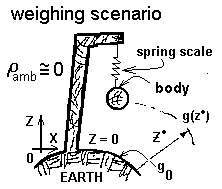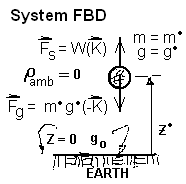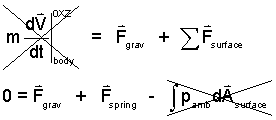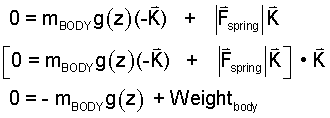| THERMO Spoken Here! ~ J. Pohl © ( A4040~3/15) | ( A4100 - Hand Supports Mass) |
1.15 Weight and Weighing
The phenomenon of mutual attraction between masses and the very great mass of Earth is called "gravity." Newton recognized that a gravity force acted on every system (BODY) as a consequence of its mass. The magnitude of the gravity force equals the "weight" of the BODY. Hence "weighing" or to weigh a BODY is to measure the magnitude of the attractive force of Earth.
Measurement of Weight: Devices have been designed, constructed and calibrated for the measurement of the magnitude of the, BODY to Earth, gravitational force. That act of such measurement is called "weighing" and the devices used are called scales.
One common weighing devices is the calibrated spring scale.

The sketch shows a "weighing scenario" in which a BODY (to be weighed) is supported by a structure that includes a "spring scale." Such devices are constructed from quality steel formed into helical springs. After fabrication the length-to-force behavior of each spring is calibrated with standard weights such the length of stretch corresponds to the force experienced. The apparatus of the sketch is exaggerated to imply (incorrectly) that such weighing might be done at great elevations, Z*.
In the scenario, the apparatus shows the mass of the body (which is known to be m*), at the elevation above Earth (being Z*). The case of the calibrated spring has a imprinted scale with its units (say Newtons) scribed thereon. So, we read the extension, (or scale reading (S.R.)*) and proclaim the weight of the mass as: WEIGHTmass* = (S.R.)* Newtons. Weighing something small can be a simple matter. Given the apparatus and a ladder that extends to the elevation, Z*, to weigh, one need only climb the ladder and read the scale.

Calculation of Weight: As a consequence of Newton's postulation of the Gravitation and the determination of its (missing for now??) The calculation begins with the body being taken as a system or FBD, as shown.
The FBD is shown twice. The first image shoiws the spring force and gravity force. Below that sketch is a second sketch of pressure-forces.
Next Newton's Second Law is applied. The momentum is constant, its derivative is zero (left-of-equality). The BODY force is gravity. The surface forces are the pull of the spring and the "float" of the ambient air. We assume the ambient density to equal zero. Hence pressure forces over tht BODY are zero.

| (1) 1 |
The magnitude of gravity is mg and it acts in the "-K." The magnitude of the spring force is not known but it acts in the "K." Put these ideas in and solve.

| (2) 2 |
This calculation was made swiftly by ignoring the density of the ambient gas. More on this later.
1.15 Weight and Weighing
The phenomenon of mutual attraction between masses and the very great mass of Earth is called "gravity." Newton recognized that a gravity force acted on every system (BODY) as a consequence of its mass. The magnitude of the gravity force equals the "weight" of the BODY. Hence "weighing" or to weigh a BODY is to measure the magnitude of the attractive force of Earth.
Premise presently unwritted!